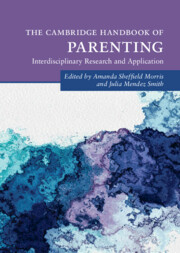Book contents
- The Cambridge Handbook of Parenting
- Cambridge Handbooks in Psychology
- The Cambridge Handbook of Parenting
- Copyright page
- Dedication
- Contents
- Contributors
- Figures
- Tables
- Introduction
- Part I Foundations of Parenting
- Part II Parenting across Development: Social, Emotional, and Cognitive Influences
- Part III Parental Factors That Impact Parenting
- 13 Mental Health and Parenting
- 14 Ethnicity and Race as a Context for Parenting: An Examination of Academic Socialization, Cultural Socialization, and Teachings about Discrimination
- 15 The Role of Fathers in Caregiving
- 16 Understanding Parenting through a Family Systems Lens
- Part IV Child Factors that Impact Parenting
- Part V Parent Education, Intervention and Policy
- Index
- References
16 - Understanding Parenting through a Family Systems Lens
from Part III - Parental Factors That Impact Parenting
Published online by Cambridge University Press: 01 December 2022
- The Cambridge Handbook of Parenting
- Cambridge Handbooks in Psychology
- The Cambridge Handbook of Parenting
- Copyright page
- Dedication
- Contents
- Contributors
- Figures
- Tables
- Introduction
- Part I Foundations of Parenting
- Part II Parenting across Development: Social, Emotional, and Cognitive Influences
- Part III Parental Factors That Impact Parenting
- 13 Mental Health and Parenting
- 14 Ethnicity and Race as a Context for Parenting: An Examination of Academic Socialization, Cultural Socialization, and Teachings about Discrimination
- 15 The Role of Fathers in Caregiving
- 16 Understanding Parenting through a Family Systems Lens
- Part IV Child Factors that Impact Parenting
- Part V Parent Education, Intervention and Policy
- Index
- References
Summary
This chapter provides an overview of understanding parenting using a family systems lens with consideration of diversity in family structures as well as adversity and resilience using the example of poverty. First, an overview of key concepts in systems perspectives is introduced. Second, family adaptive systems are presented as a promising guide to family systems to guide parenting. Third, examples of using a systems lens to understand parenting are provided, focusing on variation in family forms and the ecosystem stressor of poverty as a form of adversity, and resilience. Selected recommendations for advancing parenting research and practice are highlighted.
- Type
- Chapter
- Information
- The Cambridge Handbook of Parenting , pp. 353 - 374Publisher: Cambridge University PressPrint publication year: 2022

